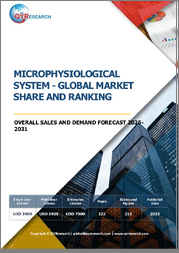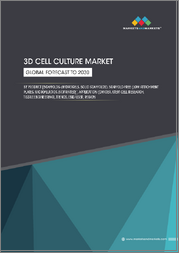
|
시장보고서
상품코드
1839506
세계의 생체 모방 시스템(MPS) 시장 - 점유율, 랭킹, 전체 매출, 수요 예측(2025-2031년)Microphysiological System- Global Market Share and Ranking, Overall Sales and Demand Forecast 2025-2031 |
||||||
세계의 생체 모방 시스템(MPS) 시장 규모는 2024년에 1억 2,641만 달러로 평가되었고, 2031년까지 3억 7,031만 달러에 달할 것으로 예상되며, 예측 기간인 2025-2031년에 CAGR은 16.23%를 나타낼 것으로 전망됩니다.
북미 시장 규모는 2024년에 5,517만 달러로 평가되었고, 2031년까지 1억 5,443만 달러에 이르며, 2025-2031년 예측 기간의 CAGR은 15.34%를 나타낼 전망입니다.
아시아태평양 시장 규모는 2024년에 1,507만 달러로 평가되었고, 2031년까지 5,372만 달러에 이르며, 2025-2031년 예측 기간의 CAGR은 19.58%를 나타낼 것으로 예상됩니다.
유럽 시장 규모는 2024년에 5,179만 달러로 평가되었고, 2031년까지 1억 4,769만 달러에 이르며, 2025-2031년 예측 기간의 CAGR은 15.83%를 나타낼 전망입니다.
세계의 생체 모방 시스템(MPS) 주요 기업은 Emulate, Mimetas, InSphero, TissUse, CN Bio, Valo Health(TARA Biosystems), Hesperos, TNO, 28bio, Newcells Biotech 등입니다. 2024년 세계 대형 5개사가 수익으로 약 48.81%의 점유율을 차지했습니다.
본 보고서는 세계의 생체 모방 시스템(MPS) 시장에 대한 조사 분석을 통해 각 지역 시장 규모와 예측, 동향과 성장 촉진요인, 주요기업 시장 점유율과 순위 등의 정보를 제공합니다.
자주 묻는 질문
목차
제1장 시장 개요
- 생체 모방 시스템(MPS) 제품 소개
- 세계의 생체 모방 시스템(MPS) 시장 규모 예측(2020-2031년)
- 생체 모방 시스템(MPS) 시장 동향과 성장 촉진요인
- 생체 모방 시스템(MPS) 산업 동향
- 생체 모방 시스템(MPS) 시장 성장 촉진요인과 기회
- 생체 모방 시스템(MPS) 시장 과제
- 생체 모방 시스템(MPS) 시장 성장 억제요인
- 이 산업에 대한 정부의 정책 지원
- 관련 기술의 비교
- 전제조건과 제한
- 조사 목적
- 고려 연도
제2장 경쟁 분석 : 기업별
- 세계의 생체 모방 시스템(MPS) 기업 수익 랭킹(2024년)
- 세계의 생체 모방 시스템(MPS) 매출 금액 : 기업별(2020-2025년)
- 생체 모방 시스템(MPS) 주요 기업의 본사와 판매 지역
- 생체 모방 시스템(MPS) 주요 기업의 제품
- 생체 모방 시스템(MPS) 주요 기업 설립일
- 생체 모방 시스템(MPS) 시장 경쟁 분석
- 생체 모방 시스템(MPS) 시장 집중도(2020-2025년)
- 세계의 생체 모방 시스템(MPS) 수익에 있어서 3대·5대 기업(2024년)
- 세계 주요 기업 : 기업 유형별(Tier 1·Tier 2·Tier 3)(2024년 기준의 생체 모방 시스템(MPS) 수익에 기초)
- 합병·인수, 확대
제3장 부문 : 유형별
- 서론 : 유형별
- 인간 장기 및 조직 모델
- 질병 모델
- 비인간 종 모델
- 세계의 생체 모방 시스템(MPS) 매출 금액 : 유형별
- 세계의 생체 모방 시스템(MPS) 매출 금액 : 유형별(2020년vs2024년vs2031년)
- 세계의 생체 모방 시스템(MPS) 매출 금액 : 유형별(2020-2031년)
- 세계의 생체 모방 시스템(MPS) 매출 금액 : 유형별(2020-2031년)
제4장 부문 : 최종 사용자별
- 서론 : 최종 사용자별
- 제약 및 바이오테크놀러지 기업
- 학술 및 연구 기관
- 기타
- 세계의 생체 모방 시스템(MPS) 매출 금액 : 최종 사용자별
- 세계의 생체 모방 시스템(MPS) 매출 금액 : 최종 사용자별(2020년vs2024년vs2031년)
- 세계의 생체 모방 시스템(MPS) 매출 금액 : 최종 사용자별(2020-2031년)
- 세계의 생체 모방 시스템(MPS) 매출 금액 : 최종 사용자별(2020-2031년)
제5장 부문 : 지역별
- 세계의 생체 모방 시스템(MPS) 매출 금액 : 지역별
- 세계의 생체 모방 시스템(MPS) 매출 금액 : 지역별(2020년·2024년·2031년)
- 세계의 생체 모방 시스템(MPS) 매출 금액 : 지역별(2020-2025년)
- 세계의 생체 모방 시스템(MPS) 매출 금액 : 지역별(2026-2031년)
- 세계의 생체 모방 시스템(MPS) 매출 금액 : 지역별(2020-2031년)
- 북미
- 북미의 생체 모방 시스템(MPS) 매출 금액(2020-2031년)
- 북미의 생체 모방 시스템(MPS) 매출 금액 : 국가별(2024년·2031년)
- 유럽
- 유럽의 생체 모방 시스템(MPS) 매출 금액(2020-2031년)
- 유럽의 생체 모방 시스템(MPS) 매출 금액 : 국가별(2024년·2031년)
- 아시아태평양
- 아시아태평양의 생체 모방 시스템(MPS) 매출 금액(2020-2031년)
- 아시아태평양의 생체 모방 시스템(MPS) 매출 금액 : 지역별(2024년·2031년)
- 라틴아메리카
- 라틴아메리카의 생체 모방 시스템(MPS) 매출 금액(2020-2031년)
- 남미의 생체 모방 시스템(MPS) 매출 금액 : 국가별(2024년·2031년)
- 중동 및 아프리카
- 중동 및 아프리카의 생체 모방 시스템(MPS) 매출 금액(2020-2031년)
- 중동 및 아프리카의 생체 모방 시스템(MPS) 매출 금액 : 국가별(2024년·2031년)
제6장 부문 : 주요 국가/지역별
- 주요국가/지역의 생체 모방 시스템(MPS) 매출 금액 성장 동향(2020년·2024년·2031년)
- 주요국가/지역의 생체 모방 시스템(MPS) 매출 금액(2020-2031년)
- 미국
- 미국의 생체 모방 시스템(MPS) 매출 금액(2020-2031년)
- 미국의 생체 모방 시스템(MPS) 매출 금액 : 유형별(2024년vs2031년)
- 미국의 생체 모방 시스템(MPS) 매출 금액 : 최종 사용자별(2024년·2031년)
- 유럽
- 유럽의 생체 모방 시스템(MPS) 매출 금액(2020-2031년)
- 유럽의 생체 모방 시스템(MPS) 매출 금액 : 유형별(2024년vs2031년)
- 유럽의 생체 모방 시스템(MPS) 매출 금액 : 최종 사용자별(2024년·2031년)
- 중국
- 중국의 생체 모방 시스템(MPS) 매출 금액(2020-2031년)
- 중국의 생체 모방 시스템(MPS) 매출 금액 : 유형별(2024년vs2031년)
- 중국의 생체 모방 시스템(MPS) 매출 금액 : 최종 사용자별(2024년·2031년)
- 일본
- 일본의 생체 모방 시스템(MPS) 매출 금액(2020-2031년)
- 일본의 생체 모방 시스템(MPS) 매출 금액 : 유형별(2024년vs2031년)
- 일본의 생체 모방 시스템(MPS) 매출 금액 : 최종 사용자별(2024년·2031년)
- 동남아시아
- 동남아시아의 생체 모방 시스템(MPS) 매출 금액(2020-2031년)
- 동남아시아의 생체 모방 시스템(MPS) 매출 금액 : 유형별(2024년·2031년)
- 동남아시아의 생체 모방 시스템(MPS) 매출 금액 : 최종 사용자별(2024년·2031년)
제7장 기업 프로파일
- Emulate
- Mimetas
- TissUse
- InSphero
- Hesperos
- CN Bio
- TNO
- 28bio
- Beijing Daxiang Biotech
- Newcells Biotech
- Nortis(Quris-Al)
- Valo Health(TARA Biosystems)
- Altis Biosystems
- Draper Laboratory
- Netri
- Bi/ond
- ImmuONE
- AlveoliX
- Cherry Biotech
- Ananda Devices
- Obatala Sciences
- BiomimX
- React4life
- Aracari Bio
- StemPharm
- SynVivo
제8장 산업 체인 분석
- 생체 모방 시스템(MPS) 산업 체인
- 산업 체인 맵
- 생체 모방 시스템(MPS) 업스트림 분석
- 업스트림 분석
- 원재료의 주요 공급업체
- 제조 비용 구조
- 다운스트림 분석(고객 분석)
- 주요 비즈니스 모델
- 판매 모델 및 판매 채널
제9장 조사 결과와 결론
제10장 부록
KTH 25.10.22The global market for Microphysiological System was valued at US$ 126.41 million in 2024 and is forecast to a readjusted size of US$ 370.31 million by 2031 with a CAGR of 16.23% during the forecast period 2025-2031.
North American market for Microphysiological System was valued at $ 55.17 million in 2024 and will reach $ 154.43 million by 2031, at a CAGR of 15.34% during the forecast period of 2025 through 2031.
Asia-Pacific market for Microphysiological System was valued at $ 15.07 million in 2024 and will reach $ 53.72 million by 2031, at a CAGR of 19.58% during the forecast period of 2025 through 2031.
Europe market for Microphysiological System was valued at $ 51.79 million in 2024 and will reach $ 147.69 million by 2031, at a CAGR of 15.83% during the forecast period of 2025 through 2031.
The global key companies of Microphysiological System include Emulate, Mimetas, InSphero, TissUse, CN Bio, Valo Health (TARA Biosystems), Hesperos, TNO, 28bio, Newcells Biotech, etc. In 2024, the global five largest players hold a share approximately 48.81% in terms of revenue.
This report aims to provide a comprehensive presentation of the global market for Microphysiological System, focusing on the total sales revenue, key companies market share and ranking, together with an analysis of Microphysiological System by region & country, by Type, and by End User.
The Microphysiological System market size, estimations, and forecasts are provided in terms of sales revenue ($ millions), considering 2024 as the base year, with history and forecast data for the period from 2020 to 2031. With both quantitative and qualitative analysis, to help readers develop business/growth strategies, assess the market competitive situation, analyze their position in the current marketplace, and make informed business decisions regarding Microphysiological System.
Market Segmentation
By Company
- Emulate
- Mimetas
- TissUse
- InSphero
- Hesperos
- CN Bio
- TNO
- 28bio
- Beijing Daxiang Biotech
- Newcells Biotech
- Nortis (Quris-Al)
- Valo Health (TARA Biosystems)
- Altis Biosystems
- Draper Laboratory
- Netri
- Bi/ond
- ImmuONE
- AlveoliX
- Cherry Biotech
- Ananda Devices
- Obatala Sciences
- BiomimX
- React4life
- Aracari Bio
- StemPharm
- SynVivo
Segment by Type
- Human Organ and Tissue Models
- Disease Models
- Non-Human Species Models
Segment by End User
- Pharmaceutical & Biotechnology Companies
- Academic & Research Institutes
- Others
By Region
- North America
- United States
- Canada
- Asia-Pacific
- China
- Japan
- South Korea
- Southeast Asia
- India
- Australia
- Rest of Asia-Pacific
- Europe
- Germany
- France
- U.K.
- Italy
- Netherlands
- Nordic Countries
- Rest of Europe
- Latin America
- Mexico
- Brazil
- Rest of Latin America
- Middle East & Africa
- Turkey
- Saudi Arabia
- UAE
- Rest of MEA
Chapter Outline
Chapter 1: Introduces the report scope of the report, global total market size. This chapter also provides the market dynamics, latest developments of the market, the driving factors and restrictive factors of the market, the challenges and risks faced by manufacturers in the industry, and the analysis of relevant policies in the industry.
Chapter 2: Detailed analysis of Microphysiological System company competitive landscape, revenue market share, latest development plan, merger, and acquisition information, etc.
Chapter 3: Provides the analysis of various market segments by Type, covering the market size and development potential of each market segment, to help readers find the blue ocean market in different market segments.
Chapter 4: Provides the analysis of various market segments by End User, covering the market size and development potential of each market segment, to help readers find the blue ocean market in different downstream markets.
Chapter 5: Revenue of Microphysiological System in regional level. It provides a quantitative analysis of the market size and development potential of each region and introduces the market development, future development prospects, market space, and market size of each country in the world.
Chapter 6: Revenue of Microphysiological System in country level. It provides sigmate data by Type, and by End User for each country/region.
Chapter 7: Provides profiles of key players, introducing the basic situation of the main companies in the market in detail, including product revenue, gross margin, product introduction, recent development, etc.
Chapter 8: Analysis of industrial chain, including the upstream and downstream of the industry.
Chapter 9: Conclusion.
Table of Contents
1 Market Overview
- 1.1 Microphysiological System Product Introduction
- 1.2 Global Microphysiological System Market Size Forecast (2020-2031)
- 1.3 Microphysiological System Market Trends & Drivers
- 1.3.1 Microphysiological System Industry Trends
- 1.3.2 Microphysiological System Market Drivers & Opportunity
- 1.3.3 Microphysiological System Market Challenges
- 1.3.4 Microphysiological System Market Restraints
- 1.4 Government Policy Support for The Industry
- 1.5 Comparison of Related Technologies
- 1.6 Assumptions and Limitations
- 1.7 Study Objectives
- 1.8 Years Considered
2 Competitive Analysis by Company
- 2.1 Global Microphysiological System Players Revenue Ranking (2024)
- 2.2 Global Microphysiological System Revenue by Company (2020-2025)
- 2.3 Key Companies Microphysiological System Headquarters and Sales Area
- 2.4 Key Companies Microphysiological System Product Offered
- 2.5 Establish Date of Key Microphysiological System Companies
- 2.6 Microphysiological System Market Competitive Analysis
- 2.6.1 Microphysiological System Market Concentration Rate (2020-2025)
- 2.6.2 Global 3 and 5 Largest Companies by Microphysiological System Revenue in 2024
- 2.6.3 Global Top Companies by Company Type (Tier 1, Tier 2, and Tier 3) & (based on the Revenue in Microphysiological System as of 2024)
- 2.7 Mergers & Acquisitions, Expansion
3 Segmentation by Type
- 3.1 Introduction by Type
- 3.1.1 Human Organ and Tissue Models
- 3.1.2 Disease Models
- 3.1.3 Non-Human Species Models
- 3.2 Global Microphysiological System Sales Value by Type
- 3.2.1 Global Microphysiological System Sales Value by Type (2020 VS 2024 VS 2031)
- 3.2.2 Global Microphysiological System Sales Value, by Type (2020-2031)
- 3.2.3 Global Microphysiological System Sales Value, by Type (%) (2020-2031)
4 Segmentation by End User
- 4.1 Introduction by End User
- 4.1.1 Pharmaceutical & Biotechnology Companies
- 4.1.2 Academic & Research Institutes
- 4.1.3 Others
- 4.2 Global Microphysiological System Sales Value by End User
- 4.2.1 Global Microphysiological System Sales Value by End User (2020 VS 2024 VS 2031)
- 4.2.2 Global Microphysiological System Sales Value, by End User (2020-2031)
- 4.2.3 Global Microphysiological System Sales Value, by End User (%) (2020-2031)
5 Segmentation by Region
- 5.1 Global Microphysiological System Sales Value by Region
- 5.1.1 Global Microphysiological System Sales Value by Region: 2020 VS 2024 VS 2031
- 5.1.2 Global Microphysiological System Sales Value by Region (2020-2025)
- 5.1.3 Global Microphysiological System Sales Value by Region (2026-2031)
- 5.1.4 Global Microphysiological System Sales Value by Region (%), (2020-2031)
- 5.2 North America
- 5.2.1 North America Microphysiological System Sales Value, 2020-2031
- 5.2.2 North America Microphysiological System Sales Value by Country (%), 2024 VS 2031
- 5.3 Europe
- 5.3.1 Europe Microphysiological System Sales Value, 2020-2031
- 5.3.2 Europe Microphysiological System Sales Value by Country (%), 2024 VS 2031
- 5.4 Asia Pacific
- 5.4.1 Asia Pacific Microphysiological System Sales Value, 2020-2031
- 5.4.2 Asia Pacific Microphysiological System Sales Value by Region (%), 2024 VS 2031
- 5.5 Latin America
- 5.5.1 Latin America Microphysiological System Sales Value, 2020-2031
- 5.5.2 South America Microphysiological System Sales Value by Country (%), 2024 VS 2031
- 5.6 Middle East & Africa
- 5.6.1 Middle East & Africa Microphysiological System Sales Value, 2020-2031
- 5.6.2 Middle East & Africa Microphysiological System Sales Value by Country (%), 2024 VS 2031
6 Segmentation by Key Countries/Regions
- 6.1 Key Countries/Regions Microphysiological System Sales Value Growth Trends, 2020 VS 2024 VS 2031
- 6.2 Key Countries/Regions Microphysiological System Sales Value, 2020-2031
- 6.3 United States
- 6.3.1 United States Microphysiological System Sales Value, 2020-2031
- 6.3.2 United States Microphysiological System Sales Value by Type (%), 2024 VS 2031
- 6.3.3 United States Microphysiological System Sales Value by End User, 2024 VS 2031
- 6.4 Europe
- 6.4.1 Europe Microphysiological System Sales Value, 2020-2031
- 6.4.2 Europe Microphysiological System Sales Value by Type (%), 2024 VS 2031
- 6.4.3 Europe Microphysiological System Sales Value by End User, 2024 VS 2031
- 6.5 China
- 6.5.1 China Microphysiological System Sales Value, 2020-2031
- 6.5.2 China Microphysiological System Sales Value by Type (%), 2024 VS 2031
- 6.5.3 China Microphysiological System Sales Value by End User, 2024 VS 2031
- 6.6 Japan
- 6.6.1 Japan Microphysiological System Sales Value, 2020-2031
- 6.6.2 Japan Microphysiological System Sales Value by Type (%), 2024 VS 2031
- 6.6.3 Japan Microphysiological System Sales Value by End User, 2024 VS 2031
- 6.7 Southeast Asia
- 6.7.1 Southeast Asia Microphysiological System Sales Value, 2020-2031
- 6.7.2 Southeast Asia Microphysiological System Sales Value by Type (%), 2024 VS 2031
- 6.7.3 Southeast Asia Microphysiological System Sales Value by End User, 2024 VS 2031
7 Company Profiles
- 7.1 Emulate
- 7.1.1 Emulate Profile
- 7.1.2 Emulate Main Business
- 7.1.3 Emulate Microphysiological System Products, Services and Solutions
- 7.1.4 Emulate Microphysiological System Revenue (US$ Million) & (2020-2025)
- 7.1.5 Emulate Recent Developments
- 7.2 Mimetas
- 7.2.1 Mimetas Profile
- 7.2.2 Mimetas Main Business
- 7.2.3 Mimetas Microphysiological System Products, Services and Solutions
- 7.2.4 Mimetas Microphysiological System Revenue (US$ Million) & (2020-2025)
- 7.2.5 Mimetas Recent Developments
- 7.3 TissUse
- 7.3.1 TissUse Profile
- 7.3.2 TissUse Main Business
- 7.3.3 TissUse Microphysiological System Products, Services and Solutions
- 7.3.4 TissUse Microphysiological System Revenue (US$ Million) & (2020-2025)
- 7.4 InSphero
- 7.4.1 InSphero Profile
- 7.4.2 InSphero Main Business
- 7.4.3 InSphero Microphysiological System Products, Services and Solutions
- 7.4.4 InSphero Microphysiological System Revenue (US$ Million) & (2020-2025)
- 7.4.5 InSphero Recent Developments
- 7.5 Hesperos
- 7.5.1 Hesperos Profile
- 7.5.2 Hesperos Main Business
- 7.5.3 Hesperos Microphysiological System Products, Services and Solutions
- 7.5.4 Hesperos Microphysiological System Revenue (US$ Million) & (2020-2025)
- 7.5.5 Hesperos Recent Developments
- 7.6 CN Bio
- 7.6.1 CN Bio Profile
- 7.6.2 CN Bio Main Business
- 7.6.3 CN Bio Microphysiological System Products, Services and Solutions
- 7.6.4 CN Bio Microphysiological System Revenue (US$ Million) & (2020-2025)
- 7.6.5 CN Bio Recent Developments
- 7.7 TNO
- 7.7.1 TNO Profile
- 7.7.2 TNO Main Business
- 7.7.3 TNO Microphysiological System Products, Services and Solutions
- 7.7.4 TNO Microphysiological System Revenue (US$ Million) & (2020-2025)
- 7.8 28bio
- 7.8.1 28bio Profile
- 7.8.2 28bio Main Business
- 7.8.3 28bio Microphysiological System Products, Services and Solutions
- 7.8.4 28bio Microphysiological System Revenue (US$ Million) & (2020-2025)
- 7.8.5 28bio Recent Developments
- 7.9 Beijing Daxiang Biotech
- 7.9.1 Beijing Daxiang Biotech Profile
- 7.9.2 Beijing Daxiang Biotech Main Business
- 7.9.3 Beijing Daxiang Biotech Microphysiological System Products, Services and Solutions
- 7.9.4 Beijing Daxiang Biotech Microphysiological System Revenue (US$ Million) & (2020-2025)
- 7.10 Newcells Biotech
- 7.10.1 Newcells Biotech Profile
- 7.10.2 Newcells Biotech Main Business
- 7.10.3 Newcells Biotech Microphysiological System Products, Services and Solutions
- 7.10.4 Newcells Biotech Microphysiological System Revenue (US$ Million) & (2020-2025)
- 7.10.5 Newcells Biotech Recent Developments
- 7.11 Nortis (Quris-Al)
- 7.11.1 Nortis (Quris-Al) Profile
- 7.11.2 Nortis (Quris-Al) Main Business
- 7.11.3 Nortis (Quris-Al) Microphysiological System Products, Services and Solutions
- 7.11.4 Nortis (Quris-Al) Microphysiological System Revenue (US$ Million) & (2020-2025)
- 7.11.5 Nortis (Quris-Al) Recent Developments
- 7.12 Valo Health (TARA Biosystems)
- 7.12.1 Valo Health (TARA Biosystems) Profile
- 7.12.2 Valo Health (TARA Biosystems) Main Business
- 7.12.3 Valo Health (TARA Biosystems) Microphysiological System Products, Services and Solutions
- 7.12.4 Valo Health (TARA Biosystems) Microphysiological System Revenue (US$ Million) & (2020-2025)
- 7.12.5 Valo Health (TARA Biosystems) Recent Developments
- 7.13 Altis Biosystems
- 7.13.1 Altis Biosystems Profile
- 7.13.2 Altis Biosystems Main Business
- 7.13.3 Altis Biosystems Microphysiological System Products, Services and Solutions
- 7.13.4 Altis Biosystems Microphysiological System Revenue (US$ Million) & (2020-2025)
- 7.13.5 Altis Biosystems Recent Developments
- 7.14 Draper Laboratory
- 7.14.1 Draper Laboratory Profile
- 7.14.2 Draper Laboratory Main Business
- 7.14.3 Draper Laboratory Microphysiological System Products, Services and Solutions
- 7.14.4 Draper Laboratory Microphysiological System Revenue (US$ Million) & (2020-2025)
- 7.14.5 Draper Laboratory Recent Developments
- 7.15 Netri
- 7.15.1 Netri Profile
- 7.15.2 Netri Main Business
- 7.15.3 Netri Microphysiological System Products, Services and Solutions
- 7.15.4 Netri Microphysiological System Revenue (US$ Million) & (2020-2025)
- 7.15.5 Netri Recent Developments
- 7.16 Bi/ond
- 7.16.1 Bi/ond Profile
- 7.16.2 Bi/ond Main Business
- 7.16.3 Bi/ond Microphysiological System Products, Services and Solutions
- 7.16.4 Bi/ond Microphysiological System Revenue (US$ Million) & (2020-2025)
- 7.17 ImmuONE
- 7.17.1 ImmuONE Profile
- 7.17.2 ImmuONE Main Business
- 7.17.3 ImmuONE Microphysiological System Products, Services and Solutions
- 7.17.4 ImmuONE Microphysiological System Revenue (US$ Million) & (2020-2025)
- 7.17.5 ImmuONE Recent Developments
- 7.18 AlveoliX
- 7.18.1 AlveoliX Profile
- 7.18.2 AlveoliX Main Business
- 7.18.3 AlveoliX Microphysiological System Products, Services and Solutions
- 7.18.4 AlveoliX Microphysiological System Revenue (US$ Million) & (2020-2025)
- 7.18.5 AlveoliX Recent Developments
- 7.19 Cherry Biotech
- 7.19.1 Cherry Biotech Profile
- 7.19.2 Cherry Biotech Main Business
- 7.19.3 Cherry Biotech Microphysiological System Products, Services and Solutions
- 7.19.4 Cherry Biotech Microphysiological System Revenue (US$ Million) & (2020-2025)
- 7.19.5 Cherry Biotech Recent Developments
- 7.20 Ananda Devices
- 7.20.1 Ananda Devices Profile
- 7.20.2 Ananda Devices Main Business
- 7.20.3 Ananda Devices Microphysiological System Products, Services and Solutions
- 7.20.4 Ananda Devices Microphysiological System Revenue (US$ Million) & (2020-2025)
- 7.20.5 Ananda Devices Recent Developments
- 7.21 Obatala Sciences
- 7.21.1 Obatala Sciences Profile
- 7.21.2 Obatala Sciences Main Business
- 7.21.3 Obatala Sciences Microphysiological System Products, Services and Solutions
- 7.21.4 Obatala Sciences Microphysiological System Revenue (US$ Million) & (2020-2025)
- 7.21.5 Obatala Sciences Recent Developments
- 7.22 BiomimX
- 7.22.1 BiomimX Profile
- 7.22.2 BiomimX Main Business
- 7.22.3 BiomimX Microphysiological System Products, Services and Solutions
- 7.22.4 BiomimX Microphysiological System Revenue (US$ Million) & (2020-2025)
- 7.22.5 BiomimX Recent Developments
- 7.23 React4life
- 7.23.1 React4life Profile
- 7.23.2 React4life Main Business
- 7.23.3 React4life Microphysiological System Products, Services and Solutions
- 7.23.4 React4life Microphysiological System Revenue (US$ Million) & (2020-2025)
- 7.24 Aracari Bio
- 7.24.1 Aracari Bio Profile
- 7.24.2 Aracari Bio Main Business
- 7.24.3 Aracari Bio Microphysiological System Products, Services and Solutions
- 7.24.4 Aracari Bio Microphysiological System Revenue (US$ Million) & (2020-2025)
- 7.25 StemPharm
- 7.25.1 StemPharm Profile
- 7.25.2 StemPharm Main Business
- 7.25.3 StemPharm Microphysiological System Products, Services and Solutions
- 7.25.4 StemPharm Microphysiological System Revenue (US$ Million) & (2020-2025)
- 7.26 SynVivo
- 7.26.1 SynVivo Profile
- 7.26.2 SynVivo Main Business
- 7.26.3 SynVivo Microphysiological System Products, Services and Solutions
- 7.26.4 SynVivo Microphysiological System Revenue (US$ Million) & (2020-2025)
- 7.26.5 SynVivo Recent Developments
8 Industry Chain Analysis
- 8.1 Microphysiological System Industrial Chain
- 8.2 Whole Industry Chain Map
- 8.3 Microphysiological System Upstream Analysis
- 8.3.1 Upstream Analysis
- 8.3.2 Raw Materials Key Suppliers
- 8.3.3 Manufacturing Cost Structure
- 8.4 Downstream Analysis (Customers Analysis)
- 8.5 Main Business Model
- 8.6 Sales Model and Sales Channels
9 Research Findings and Conclusion
10 Appendix
- 10.1 Research Methodology
- 10.1.1 Methodology/Research Approach
- 10.1.2 Data Source
- 10.2 Author Details
- 10.3 Disclaimer 222



















